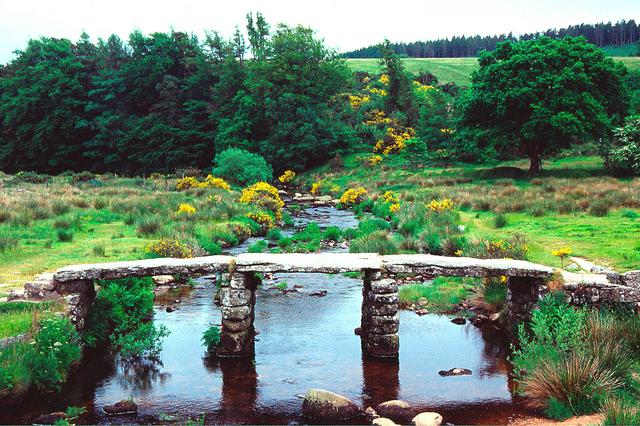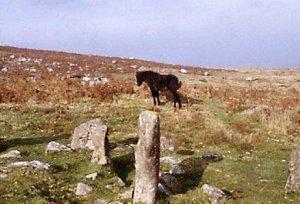Dartmoor National Park covers a large area of Devon in the West Country of England.
The 'Forest' of Dartmoor refers to a hunting area rather than an area of woodland. This is one of the best areas in the UK for Bronze Age remains and much of the moor seems almost littered with stone circles, stone rows and burial stones.

Dartmoor forest; Dartmoor prison at Princetown, built during the Napoleonic wars; Conan Doyle's book, The Hound of the Baskervilles featuring Sherlock Holmes is set in foggy Dartmoor.
Tin mining has had an important role in Dartmoor's history. The so-called stannary towns had their own assemblies, laws and courts and there was even a stannary gaol.
Rabbit rearing was important once and there are places still carrying the name of Warren.
More recently the china clay industry provided the raw materials for the Potteries area of Staffordshire.
Moorland, rocky tors & quite a lot of wet places called bogs. Tors are hills with granite outcrops.

Ferns, feral ponies, Dartmoor cattle. Foxes, buzzards and badgers in reasonable quantity.
Can be very changeable. You can be sun-burnt and get lost in mist on the same day.
- Tavistock
- Princetown
- Bovey Tracey - prehistoric remains visible all round the roads.
- Buckland-in-the-Moor - wooded area with an unusual church clock in the village - having 'My dear mother' in place of the numbers 1-12. Ten commandments are to be found in stone on nearby Buckland Beacon (very eroded).
- Chagford - a village deep in the moor.
- Cornwood - a southern Dartmoor village.
- Drewsteignton on the north-east of the moor with a great old pub, the Drewe Arms.
- Harford - a tiny village with a picturesque bridge and church near Cornwood.
- Haytor Vale - near some very striking tors.
- Lydford - A village north of Tavistock with a spectacular limestone gorge and a castle that was once used as the stannary prison.
- Mary Tavy - a pleasant moorland village north of Tavistock that generally gets less crowded than many areas but the walks are as good.
- Meavy - village green and ancient oak tree.
- Peter Tavy - as Mary Tavy above.
- Shaugh Prior - village with granite church with old china clay pits all around.
- Sheepstor - the tor is very shapely and immediately above the village, which has the tomb of James Brooke, white rajah of Sarawak.
- Widecombe-in-the-Moor - Though best known for its song it's worth seeing for its large church (sometimes known as 'the cathedral of the moor.' Good pubs.
Bovey Tracey - prehistoric remains visible all round the roads.
Buckland-in-the-Moor - wooded area with an unusual church clock in the village - having 'My dear mother' in place of the numbers 1-12. Ten commandments are to be found in stone on nearby Buckland Beacon (very eroded).
Chagford - a village deep in the moor.
Cornwood - a southern Dartmoor village.
Drewsteignton on the north-east of the moor with a great old pub, the Drewe Arms.
Harford - a tiny village with a picturesque bridge and church near Cornwood.
Haytor Vale - near some very striking tors.
Lydford - A village north of [[Tavistock]] with a spectacular limestone gorge and a castle that was once used as the stannary prison.
Mary Tavy - a pleasant moorland village north of [[Tavistock]] that generally gets less crowded than many areas but the walks are as good.
Meavy - village green and ancient oak tree.
Peter Tavy - as Mary Tavy above.
Shaugh Prior - village with granite church with old china clay pits all around.
Sheepstor - the tor is very shapely and immediately above the village, which has the tomb of James Brooke, white rajah of Sarawak.
Widecombe-in-the-Moor - Though best known for its song it's worth seeing for its large church (sometimes known as 'the cathedral of the moor.' Good pubs.
- Brent Tor - north of Tavistock - a small hill but reputedly the first sight of land for a sailor who vowed to put a church on top and the church is there.
- Burrator reservoir - this is artificial and supplies Plymouth but it seems like a natural lake from many angles - visit combines well with Meavy and Sheepstor.
- Castle Drogo, Drewsteignton, near Exeter, EX6 6PB, +44 1647 433306.
- Dartmeet - scenic junction of the West and East Dart
- Double Waters - particularly beautiful junction of the river Tavy and its tributary, the Walkham.
- Fingle Bridge - on the river Teign on the north-east of the moor.
- Fog-in-tor Quarry - (near Princetown)
- Lustleigh Cleave
- Shaugh Bridge - at the junction of the Meavy and Cad rivers to form the Plym.
Brent Tor - north of [[Tavistock]] - a small hill but reputedly the first sight of land for a sailor who vowed to put a church on top and the church is there.
Burrator reservoir - this is artificial and supplies [[Plymouth (England)|Plymouth]] but it seems like a natural lake from many angles - visit combines well with Meavy and Sheepstor.
Castle Drogo, Drewsteignton, near Exeter, EX6 6PB, +44 1647 433306.
Dartmeet - scenic junction of the West and East Dart
Double Waters - particularly beautiful junction of the river Tavy and its tributary, the Walkham.
Fingle Bridge - on the river Teign on the north-east of the moor.
Fog-in-tor Quarry - (near Princetown)
Lustleigh Cleave
Shaugh Bridge - at the junction of the Meavy and Cad rivers to form the Plym.
Letterboxing
Letterboxing is very similar to the much newer craze of Geo-caching, but has been around a lot longer.
Like geo-caching each post/letter box consists of a small weather-proof box which contains a rubber stamp and may also contain a note pad. The stamp designs are limited only by the imagination of the person who placed them, and come in a very wide range sizes. As you find each box you record your visit by taking an impression of the located stamp. Finding the boxes usually requires a series of clues, ranging from the very easy, to the fiendishly difficult. Most letterboxes are placed on the moor by private individuals, who give their clues to friends and family. Some clues will be made available for the wider community to find. Some boxes are placed by charities/groups wishing to raise a little money. These charity boxes normally form the basis of a circular route, in a particular part of Dartmoor, and usually consist of a set of stamps with a common theme. These are also only available for a short period and the clue sheets are sold for a nominal fee. Most people who do letterboxing on a regular basis will usually have their own stamp which they carry around with them to put in the notepad of the boxes they find.
Letterboxing on Dartmoor has a big following in the local region and beyond. You will find people who go out for an hour or two on their way home from work, as well as people who come down from all over, to spend a week walking to find new and exciting stamps.
The number of boxes is constantly changing as people lose, update or simply remove stamps.
The Old Police Station in Princetown serves some of the best fish and chips on the moors.
- Warren House Inn. 11AM-11PM (summer). A remote inn with great food and outdoor seating overlooking the moors. Sunday roast here is the quintessential moors experience! £7-£15.
Warren House Inn. 11AM-11PM (summer). A remote inn with great food and outdoor seating overlooking the moors. Sunday roast here is the quintessential moors experience! £7-£15.
- Peter Tavy Inn - 15th century.
- Plume of Feathers, Princetown
- Cornwood Inn
- Mary Tavy Inn - 16th century
- Royal Oak, Meavy - origins in 15th century - a very ancient oak tree on the village green (royal connections???)
- Rugglestone Inn - superb traditional inn at Widecombe.
- Old Inn, Widecombe
- Fingle Bridge Innellent setting near Drewsteignton.
- Drewe Arms, Drewsteignton
- Elephant's Nest, Horndon, Mary Tavy - 16th century - great Moorland location.
- Walkhampton Inn
- Dartmoor Inn, Lydford
- Dartmoor Inn, Merrivale - on the Tavistock to Princetown road -
Peter Tavy Inn - 15th century.
Plume of Feathers, Princetown
Cornwood Inn
Mary Tavy Inn - 16th century
Royal Oak, Meavy - origins in 15th century - a very ancient oak tree on the village green (royal connections???)
Rugglestone Inn - superb traditional inn at Widecombe.
Old Inn, Widecombe
Fingle Bridge Innellent setting near Drewsteignton.
Drewe Arms, Drewsteignton
Elephant's Nest, Horndon, Mary Tavy - 16th century - great Moorland location.
Walkhampton Inn
Dartmoor Inn, Lydford
Dartmoor Inn, Merrivale - on the [[Tavistock]] to [[Princetown]] road -
Dartmoor can be a deceptively dangerous place. The weather is very changeable and you could get surrounded in mist very quickly, in the summer it can get extremely hot and you may not be able to find shade for several miles . If you're planning on going out for a walk of any length on Dartmoor, it is best to know how to read a map and use a compass, this is vital if you plan to go off the beaten track, it can be almost impossible to navigate some areas and you will end up walking in circles. If you must use a GPS, take plenty of spare batteries.
As with any outdoor activity, it is always best to let somebody know where you're going and how long you expect to be.
